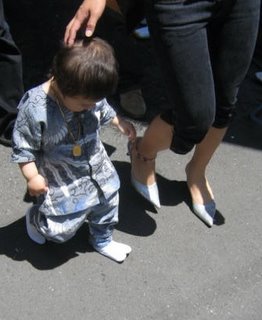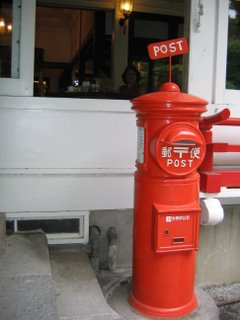
Because I’ve been to Beijing before, I haven’t felt the need to go back to sights I've seen, like Tiananmen Square and the Forbidden City, although John has been getting up early and doing most of that kind of sightseeing. Instead I’ve been catching up with people I know here and trying to see things I either haven’t seen before, or things that may not be around the next time I’m in Beijing, whenever that may be.
Yesterday John and I explored the hutongs a neighborhood that falls into both categories. A hutong is an alley, and I’d never visited this particular warren of them in the Xicheng District northeast of Tiananmen Square. Most of Beijing’s old hutong neighborhoods have been bulldozed and replaced with high-rise apartment buildings. This is probably a good thing for the residents who don’t have to live medievally anymore, but somewhat of a shame from a historical standpoint. Beijing is going through a building spasm right now to get ready for the 2008 Olympics. The authorities seem to be mostly leaving this system of hutongs alone, but only time will tell if it survives the wave of modernization.
John and I turned down the first alley we came to, and spent 45 minutes at a teashop that was only a few steps in. We realized quickly that we’d have to pace ourselves better, but it was worth it. The proprietress saw us admiring a wall full of ceramic tea mugs and spent the next half hour reeling us in gently. She had us sip cup after tiny cup of tea, including oolong, black tea with a sweet, smoky flavor far more complicated than any tea I’d ever tried before, and a brew made by dunking a ball of what looked like dried herbs in boiling water. After a few minutes, the ball opened up into a whole flower—a chrysanthemum, I think. I realized quickly that the $2.50 mugs were a loss leader and that the tea was where the profit was, but it all tasted so good that I didn’t mind. Almost an hour went by with our host praising my meager Chinese to the stars and caffeinating me to the breaking point. I did end up buying some of the black tea, which surprised even me because I’m really a coffee person. But somehow the storeowner had won me over and made me into a tea drinker in one morning.
Fueled by six different kinds of cha, John and I set out to explore further into the neighborhood. It was an appealing maze of twisting alleyways, which is a huge contrast to most of Beijing, which is laid out in an L.A.-style grid of long, wide, straight boulevards. I thought the best part of the day would be walking around the lake in the middle of the district, but the lake turned out to be lined with backpacker-friendly bars where happy hour started at 10am, and pan-Asian noodle houses that reminded John of places that catered to trekkers in Katmandu. There were also aggressive rickshaw drivers anxious to take us on tours of the neighborhood. They all knew only one word of English: “HELLO!,” barked at sea-lion volume, and if it didn’t get their attention, they would yell it louder and grab your arm to make sure you knew they were there. John knew two good tricks to get rid of them, though. The first is to simply break down and take a tour, which buys you an hour with nobody demanding you take his. We chose the second method, which was to rent bicycles. Most of the drivers understood that if we were on bikes we weren’t likely to abandon them to get in their cart, and we could outrun the few aggressive ones who persisted.
Bikes are also a good way to explore the alleys, and it was a joy to ride through narrow passageways and suddenly come out into a small hidden square containing a market and a two-table restaurant with the chef cooking skewers of meat on a tiny grill outside.
We got lost a few times, but that was part of the fun. Finally trudging back the way we’d come that morning, we got an enthusiastic wave and a hello from the tea lady, who seemed genuinely happy to see us again. We had a moment of appreciation for her and her soft-sell approach, and I hope that Beijing’s Olympic modernization drive includes an effort to rediscover a little bit of this kind of old-fashioned marketing.
Here's my Beijing photo gallery.









